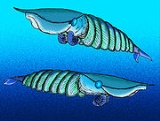
Hurdia
Encyclopedia
Hurdia victoria is an extinct species
of anomalocaridid that lived 500 million years ago during the Cambrian era
. It is part of the ancestral lineage that led to Arthropods
and is related to Anomalocaris
.
s) which shovelled food into its pineapple-ring-like mouth. A hollow, spike-shaped shell
protruded from the front of its head. The function of this organ remains mysterious; it cannot have been protective as there was no underlying soft tissue. Lateral lobes ran along the sides of the organisms, from which large gills were suspended.
as well as sites in the USA, China and Europe.
Charles Walcott in 1909, while cataloging the Burgess Shale
. However he mistakenly thought that the various body parts belonged to different creatures, which led to them being misclassified variously as a species of jellyfish
, sea cucumber and its close relative Anomalocaris.
In the late 1990s, then-curator of the Royal Ontario Museum
Desmond H. Collins
connected the elements of the Hurdia animal, presenting his ideas in informal articles, but it was not until 2009, after three years of painstaking research, that the complete organism was reconstructed.
Species
In biology, a species is one of the basic units of biological classification and a taxonomic rank. A species is often defined as a group of organisms capable of interbreeding and producing fertile offspring. While in many cases this definition is adequate, more precise or differing measures are...
of anomalocaridid that lived 500 million years ago during the Cambrian era
Cambrian
The Cambrian is the first geological period of the Paleozoic Era, lasting from Mya ; it is succeeded by the Ordovician. Its subdivisions, and indeed its base, are somewhat in flux. The period was established by Adam Sedgwick, who named it after Cambria, the Latin name for Wales, where Britain's...
. It is part of the ancestral lineage that led to Arthropods
Arthropod
An arthropod is an invertebrate animal having an exoskeleton , a segmented body, and jointed appendages. Arthropods are members of the phylum Arthropoda , and include the insects, arachnids, crustaceans, and others...
and is related to Anomalocaris
Anomalocaris
Anomalocaris is an extinct genus of anomalocaridid, which are, in turn, thought to be closely related to the arthropods. The first fossils of Anomalocaris were discovered in the Ogygopsis Shale by Joseph Frederick Whiteaves, with more examples found by Charles Doolittle Walcott in the famed...
.
Description
Hurdia was one of the largest organisms in the Cambrian oceans, reaching approximately 50 cm (1.5 feet) in length. Its head bore a pair of spiny claws (great appendageGreat appendage
Great appendages are large claw-like appendages which attach to the heads of the "great appendage arthropods", a group whose monophyly is debated, but which includes the anomalocaridids...
s) which shovelled food into its pineapple-ring-like mouth. A hollow, spike-shaped shell
Exoskeleton
An exoskeleton is the external skeleton that supports and protects an animal's body, in contrast to the internal skeleton of, for example, a human. In popular usage, some of the larger kinds of exoskeletons are known as "shells". Examples of exoskeleton animals include insects such as grasshoppers...
protruded from the front of its head. The function of this organ remains mysterious; it cannot have been protective as there was no underlying soft tissue. Lateral lobes ran along the sides of the organisms, from which large gills were suspended.
Ecology
Hurdia was a predator, or possibly a scavenger. Its claws are flimsier than those of Anomalocaris, suggesting that it fed on less robust prey. It displayed a cosmopolitan distribution; it has been recovered from the Burgess shaleBurgess Shale
The Burgess Shale Formation, located in the Canadian Rockies of British Columbia, is one of the world's most celebrated fossil fields, and the best of its kind. It is famous for the exceptional preservation of the soft parts of its fossils...
as well as sites in the USA, China and Europe.
Taxonomic history
Hurdia was first described from fragmentary fossils by American paleontologistPaleontology
Paleontology "old, ancient", ὄν, ὀντ- "being, creature", and λόγος "speech, thought") is the study of prehistoric life. It includes the study of fossils to determine organisms' evolution and interactions with each other and their environments...
Charles Walcott in 1909, while cataloging the Burgess Shale
Burgess Shale
The Burgess Shale Formation, located in the Canadian Rockies of British Columbia, is one of the world's most celebrated fossil fields, and the best of its kind. It is famous for the exceptional preservation of the soft parts of its fossils...
. However he mistakenly thought that the various body parts belonged to different creatures, which led to them being misclassified variously as a species of jellyfish
Jellyfish
Jellyfish are free-swimming members of the phylum Cnidaria. Medusa is another word for jellyfish, and refers to any free-swimming jellyfish stages in the phylum Cnidaria...
, sea cucumber and its close relative Anomalocaris.
In the late 1990s, then-curator of the Royal Ontario Museum
Royal Ontario Museum
The Royal Ontario Museum is a museum of world culture and natural history in Toronto, Ontario, Canada. With its main entrance facing Bloor Street in Downtown Toronto, the museum is situated north of Queen's Park and east of Philosopher's Walk in the University of Toronto...
Desmond H. Collins
Desmond H. Collins
Desmond H. Collins is a Canadian paleontologist, associate professor of zoology at the University of Toronto and retired curator of invertebrate paleontology at the Royal Ontario Museum.-External links:*...
connected the elements of the Hurdia animal, presenting his ideas in informal articles, but it was not until 2009, after three years of painstaking research, that the complete organism was reconstructed.

